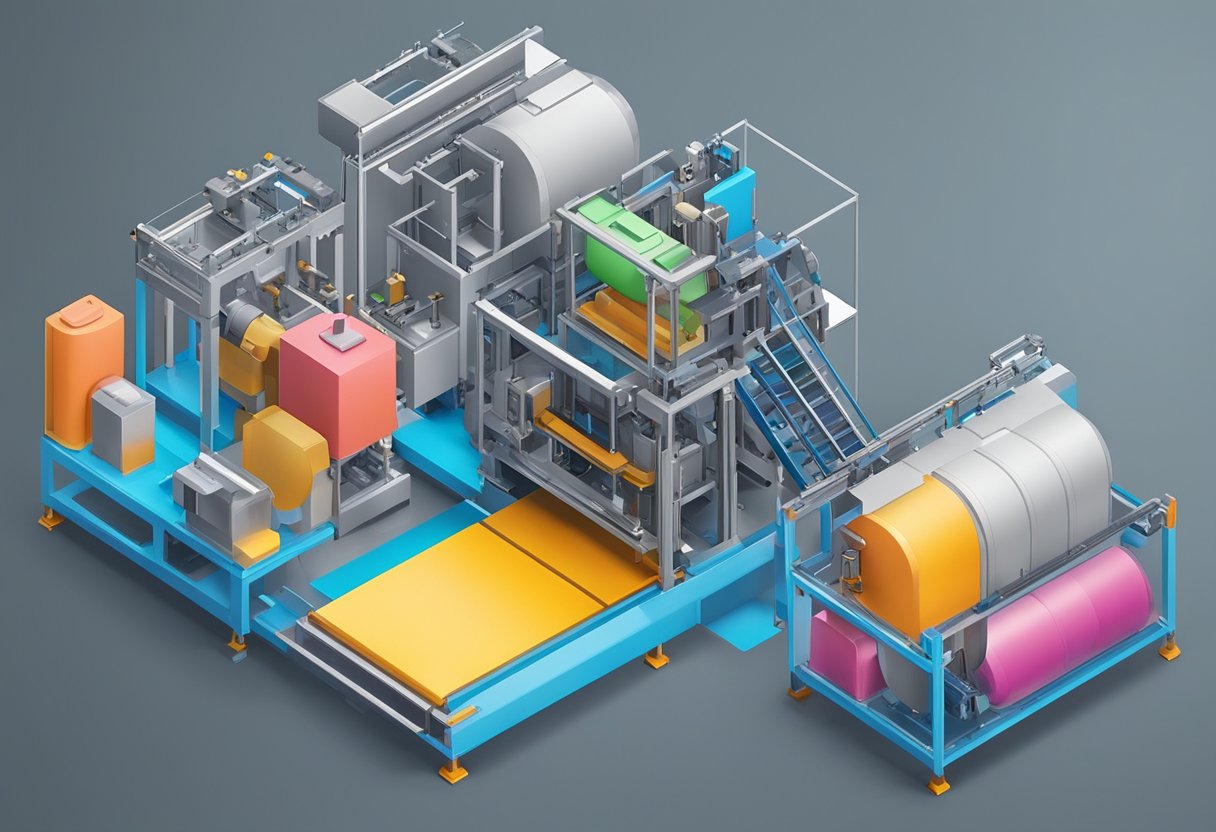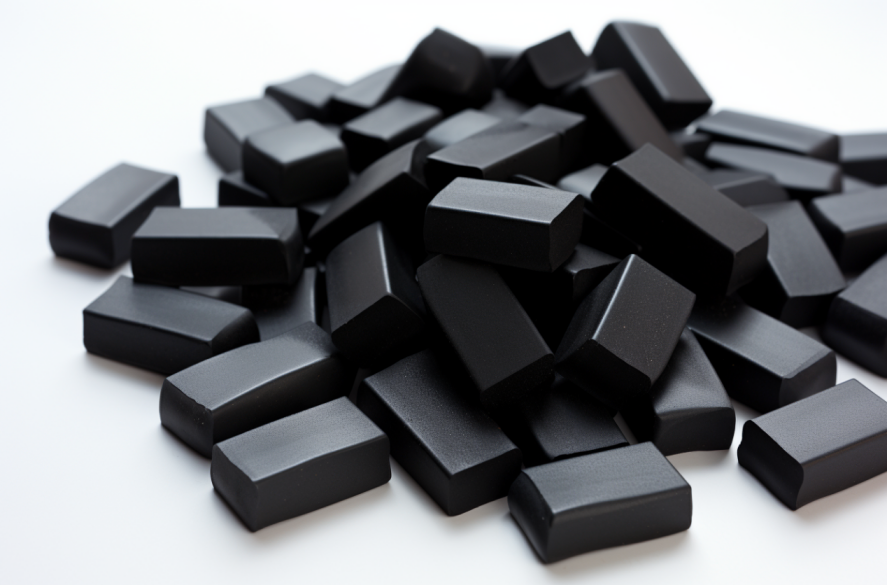Thermoplastic TPE: Properties and Applications
19/01/2024
Thermoplastic elastomers (TPE) are a class of materials that have been gaining popularity in recent years due to their unique combination of properties. They are a type of polymer that exhibits both rubber-like elasticity and thermoplastic processability, making them highly versatile and suitable for a wide range of applications. TPEs are commonly used in the automotive, medical, and consumer goods industries, among others.

One type of TPE that has been particularly successful is thermoplastic styrenic elastomers (TPS). These materials are composed of a styrene-based block copolymer that is combined with a thermoplastic elastomer. TPSs are known for their excellent mechanical properties, including high tensile strength and tear resistance, as well as their good chemical resistance and weatherability. They are often used in applications such as automotive weatherstripping, footwear, and soft-touch grips for consumer electronics.
Fundamentals of Thermoplastic TPE

Thermoplastic elastomers (TPE) are a class of materials that combine the properties of elastomers and thermoplastics. They are widely used in various industries due to their excellent flexibility, durability, and resistance to chemicals and UV light.
There are two main types of TPE: styrenic block copolymers (SBC) and thermoplastic olefins (TPO). SBC TPEs are made from styrene and butadiene, while TPO TPEs are made from a mixture of polypropylene and ethylene-propylene rubber.
TPEs can be processed using a variety of methods, including injection molding, extrusion, and blow molding. They can also be easily recycled, making them an eco-friendly option for manufacturers.
One of the key advantages of TPEs is their ability to be customized to meet specific application requirements. They can be formulated to have varying levels of hardness, flexibility, and chemical resistance. TPEs can also be blended with other materials, such as polypropylene or nylon, to enhance their properties.
Overall, TPEs are a versatile and reliable material choice for a wide range of applications, including automotive, medical, consumer goods, and more.
Types of Thermoplastic Elastomers

Thermoplastic elastomers (TPEs) are a class of polymers that exhibit both thermoplastic and elastomeric properties. TPEs are used in a variety of applications where flexibility and durability are required. There are several types of TPEs available in the market, each with its own unique set of properties and advantages.
Styrenic Block Copolymers (SBC)
Styrenic block copolymers (SBC) are a class of TPEs that are widely used in the automotive and consumer goods industries. SBCs are known for their excellent elasticity, high tensile strength, and good processability. They are also resistant to oil, grease, and chemicals, making them ideal for use in harsh environments.
Thermoplastic Polyurethanes (TPU)
Thermoplastic polyurethanes (TPU) are a class of TPEs that are widely used in the footwear and sports equipment industries. TPUs are known for their excellent abrasion resistance, high tensile strength, and good flexibility. They are also resistant to oil, grease, and chemicals, making them ideal for use in outdoor applications.
Thermoplastic Vulcanizates (TPV)
Thermoplastic vulcanizates (TPV) are a class of TPEs that are widely used in the automotive and construction industries. TPVs are known for their excellent weather resistance, high tensile strength, and good processability. They are also resistant to oil, grease, and chemicals, making them ideal for use in harsh environments.
Thermoplastic Polyester Elastomers (TPEE)
Thermoplastic polyester elastomers (TPEE) are a class of TPEs that are widely used in the medical and consumer goods industries. TPEEs are known for their excellent chemical resistance, high tensile strength, and good flexibility. They are also resistant to UV radiation and aging, making them ideal for use in outdoor applications.
Thermoplastic Polyamides (TPA)
Thermoplastic polyamides (TPA) are a class of TPEs that are widely used in the electrical and electronics industries. TPAs are known for their excellent electrical insulation properties, high tensile strength, and good processability. They are also resistant to high temperatures and chemicals, making them ideal for use in harsh environments.
In summary, TPEs are a versatile class of polymers that offer a wide range of properties and advantages. By understanding the different types of TPEs available in the market, manufacturers can choose the best material for their specific application.
Properties of Thermoplastic TPE

Thermoplastic elastomers (TPEs) are a class of materials that exhibit both thermoplastic and elastomeric properties. They are widely used in various applications due to their unique characteristics, such as flexibility, softness, and resistance to chemicals and weathering.
Here are some of the properties of thermoplastic TPE:
- Flexibility and Softness: Thermoplastic TPEs are known for their flexibility and softness, which make them ideal for applications that require a comfortable and pliable material. They can be easily molded or extruded into different shapes and sizes, and they can also be colored to match specific requirements.
- Chemical Resistance: Thermoplastic TPEs are resistant to a wide range of chemicals, including oils, solvents, and acids. This property makes them suitable for use in applications that involve exposure to harsh chemicals, such as automotive parts, medical devices, and industrial equipment.
- Weather Resistance: Thermoplastic TPEs are also resistant to weathering, which means that they can withstand exposure to sunlight, heat, and cold without deteriorating. This property makes them suitable for outdoor applications, such as seals, gaskets, and roofing materials.
- Elasticity and Resilience: Thermoplastic TPEs have the elasticity and resilience of rubber, which means that they can be stretched and compressed without losing their shape or properties. This property makes them suitable for use in applications that require a material that can absorb shock or vibration, such as shoe soles, sports equipment, and packaging materials.
In summary, thermoplastic TPEs are a versatile class of materials that offer a combination of flexibility, softness, chemical resistance, weather resistance, elasticity, and resilience. These properties make them suitable for a wide range of applications in various industries.
Processing Techniques
Injection Molding
Thermoplastic TPE can be easily molded into complex shapes using the injection molding process. The process involves melting the TPE pellets and injecting them into a mold cavity under high pressure. The mold is then cooled to solidify the material and the finished part is ejected. Injection molding is a highly efficient and cost-effective method for producing high-volume parts with consistent quality.
Extrusion
Extrusion is another popular processing technique for TPE. The process involves melting the TPE pellets and forcing them through a die to create a continuous profile. The profile is then cooled and cut to the desired length. Extrusion is commonly used to produce tubing, profiles, and seals. It is a versatile and efficient process that can produce parts with a range of properties.
Blow Molding
Blow molding is a process used to produce hollow parts such as bottles, containers, and tanks. The process involves melting the TPE pellets and blowing them into a mold cavity to form the desired shape. The mold is then cooled and the finished part is ejected. Blow molding is a cost-effective method for producing large volumes of parts with complex shapes.
Thermoforming
Thermoforming is a process used to produce thin-walled parts such as trays, lids, and packaging. The process involves heating a sheet of TPE and stretching it over a mold to create the desired shape. The mold is then cooled and the finished part is trimmed. Thermoforming is a versatile and cost-effective method for producing parts with good dimensional stability and surface finish.
Overall, thermoplastic TPE offers a range of processing techniques that can be tailored to meet specific application requirements. Each technique offers unique advantages and limitations, and careful consideration should be given to selecting the most appropriate method for a given application.
Applications in Industry
Automotive
Thermoplastic TPE has found extensive use in the automotive industry due to its unique properties such as flexibility, durability, and resistance to chemicals and UV radiation. TPE is commonly used in automotive applications such as door handles, steering wheels, airbag covers, and dashboard components. TPE’s ability to be molded into complex shapes and its cost-effectiveness make it an ideal material for automotive manufacturers.
Medical Devices
TPE is also used in the medical industry due to its biocompatibility and ability to be sterilized. TPE is commonly used in medical devices such as tubing, seals, and grips. TPE’s softness and flexibility make it an ideal material for medical devices that come in contact with the human body. TPE’s resistance to chemicals and oils also make it an ideal material for medical devices that require frequent cleaning.
Consumer Goods
TPE is widely used in consumer goods due to its versatility and cost-effectiveness. TPE is commonly used in applications such as toys, sports equipment, and household appliances. TPE’s softness and flexibility make it an ideal material for toys and sports equipment that come in contact with the human body. TPE’s resistance to chemicals and UV radiation also make it an ideal material for household appliances that require frequent cleaning.
In conclusion, thermoplastic TPE has a wide range of applications in various industries due to its unique properties. Its flexibility, durability, and resistance to chemicals and UV radiation make it an ideal material for automotive, medical, and consumer goods applications.
Material Selection Criteria
When selecting a thermoplastic TPE for a specific application, several factors must be taken into consideration. These factors include the desired physical properties, processing requirements, and the environment in which the TPE will be used.
Physical Properties
The physical properties of the TPE should align with the requirements of the application. These properties include hardness, flexibility, tensile strength, and elongation. For example, a TPE with high flexibility and elongation would be suitable for use in a product that requires a high degree of stretchability, such as a phone case. On the other hand, a TPE with high hardness and tensile strength would be appropriate for use in a product that requires rigidity, such as a car bumper.
Processing Requirements
The processing requirements of the TPE must also be taken into account. These requirements include the processing temperature, processing time, and the type of molding process. For instance, a TPE that requires a low processing temperature and short processing time would be suitable for use in a product that requires fast production, such as a toy.
Environmental Considerations
The environment in which the TPE will be used must also be considered. This includes factors such as temperature, UV exposure, and chemical exposure. For example, a TPE that is resistant to UV exposure would be appropriate for use in a product that will be exposed to sunlight, such as outdoor furniture.
By taking into account these material selection criteria, the appropriate thermoplastic TPE can be chosen for a specific application, ensuring optimal performance and durability.
Additives and Compounding
Thermoplastic elastomers (TPE) can be formulated with a variety of additives to enhance their performance and properties. These additives can be divided into two categories: fillers and processing aids.
Fillers are added to TPE to improve their mechanical properties, such as stiffness, strength, and abrasion resistance. Common fillers include carbon black, glass fibers, and mineral fillers. Carbon black is a popular filler due to its ability to improve the TPE’s resistance to UV light and its electrical conductivity. Glass fibers are often added to improve the TPE’s strength and stiffness, while mineral fillers can improve abrasion resistance and reduce cost.
Processing aids are added to TPE to improve their processing characteristics, such as melt flow, mold release, and surface finish. Common processing aids include lubricants, slip agents, and anti-static agents. Lubricants can improve the TPE’s melt flow and reduce processing time, while slip agents can improve mold release and surface finish. Anti-static agents can be added to reduce static charge buildup during processing.
Compounding is the process of mixing TPE with additives to create a homogeneous blend. Compounding can be done using a variety of methods, including melt mixing, solution mixing, and dry blending. Melt mixing is the most common method and involves melting the TPE and additives together in an extruder. Solution mixing involves dissolving the TPE and additives in a solvent and then evaporating the solvent to create a solid blend. Dry blending involves mixing the TPE and additives together in a blender or mixer without melting or dissolving them.
Overall, the addition of fillers and processing aids can significantly improve the performance and processing characteristics of TPE. Compounding is a critical step in the production of TPE, and the choice of additives and compounding method can have a significant impact on the final properties of the material.
Environmental Impact and Recycling
TPEs are considered to be a more environmentally friendly material compared to other plastics. They are recyclable and can be reused in various applications. The recycling process of TPEs is relatively simple and can be done through mechanical recycling.
Mechanical recycling involves grinding the TPE material into small pellets, which can then be melted and molded into new products. This process can be repeated several times, making TPEs a sustainable option for various industries.
In addition to recycling, TPEs have a lower environmental impact compared to traditional plastics. They are made from natural sources such as rubber and oil, which are renewable resources. TPEs also have a lower carbon footprint compared to other plastics, as they require less energy to produce.
Furthermore, TPEs do not contain harmful chemicals such as phthalates and Bisphenol A (BPA), which are commonly found in other plastics. This makes TPEs a safer option for both the environment and human health.
Overall, TPEs are a sustainable and environmentally friendly option for various industries. Their recyclability and lower environmental impact make them a popular choice for manufacturers looking to reduce their carbon footprint and promote sustainability.
Regulatory Standards and Compliance
Thermoplastic elastomers (TPE) are subject to regulatory standards and compliance requirements to ensure their safety and suitability for use in various applications. These standards and regulations vary depending on the intended use of the TPE product and the region where it will be sold.
In the United States, the Food and Drug Administration (FDA) regulates TPEs used in food contact applications. TPEs used in medical devices are regulated by the FDA under the Federal Food, Drug, and Cosmetic Act. TPEs used in other applications, such as automotive and consumer goods, may be subject to regulations from organizations such as the Consumer Product Safety Commission (CPSC) and the Environmental Protection Agency (EPA).
In the European Union, TPEs are subject to the Restriction of Hazardous Substances (RoHS) directive, which restricts the use of certain hazardous substances in electrical and electronic equipment. TPEs used in food contact applications are regulated by the European Food Safety Authority (EFSA). TPEs used in medical devices are regulated by the European Medicines Agency (EMA) under the Medical Devices Regulation (MDR).
Manufacturers of TPE products are responsible for ensuring that their products comply with all relevant regulations and standards. This includes conducting testing and providing documentation to demonstrate compliance. Compliance with these regulations and standards is important to ensure the safety and effectiveness of TPE products and to avoid potential liability issues.
Overall, regulatory standards and compliance requirements play a critical role in ensuring the safety and suitability of TPE products for their intended use. Manufacturers must stay up-to-date with the latest regulations and standards to ensure compliance and maintain the trust of their customers.
Market Trends and Future Outlook
Thermoplastic elastomers (TPE) are gaining popularity due to their unique combination of properties, such as elasticity, flexibility, and durability. The TPE market is expected to witness a significant growth in the coming years, owing to the increasing demand from various end-use industries.
The automotive industry is one of the major consumers of TPEs, as they are used in various applications such as interior and exterior trims, seals, gaskets, and hoses. The growing demand for lightweight and fuel-efficient vehicles is expected to drive the demand for TPEs in the automotive sector.
The healthcare industry is another significant consumer of TPEs, as they are used in medical devices, surgical instruments, and drug delivery systems. The increasing aging population and the rising prevalence of chronic diseases are expected to boost the demand for TPEs in the healthcare sector.
The packaging industry is also witnessing a growing demand for TPEs, as they are used in food packaging, beverage packaging, and personal care packaging. The increasing demand for sustainable and eco-friendly packaging solutions is expected to drive the growth of the TPE market in the packaging sector.
In terms of geography, Asia-Pacific is expected to dominate the TPE market, owing to the increasing demand from countries such as China, India, and Japan. The growing population, rising disposable income, and increasing industrialization in these countries are expected to drive the demand for TPEs in various end-use industries.
Overall, the TPE market is expected to witness a steady growth in the coming years, owing to the increasing demand from various end-use industries. However, the market is also facing some challenges such as the availability of raw materials and the fluctuating prices of crude oil. Manufacturers are focusing on developing bio-based TPEs to overcome these challenges and meet the growing demand for sustainable and eco-friendly products.
Frequently Asked Questions
What are the primary applications of thermoplastic elastomers?
Thermoplastic elastomers (TPEs) are widely used in various industries due to their unique properties. They are commonly used in automotive, consumer goods, and medical industries. TPEs are used to produce soft-touch grips, seals, gaskets, and other components that require flexibility and durability.
How do manufacturers produce thermoplastic elastomers?
Manufacturers produce TPEs by blending two or more polymers. The blending process is done by either melt blending or solution blending. Melt blending involves melting the polymers and mixing them together, while solution blending involves dissolving the polymers in a solvent and then mixing them together.
Can you provide a basic composition formula for thermoplastic elastomers?
The composition of TPEs varies depending on the desired properties. However, a basic formula for TPEs is a blend of a thermoplastic polymer and an elastomer. The thermoplastic polymer provides strength and rigidity, while the elastomer provides flexibility and elasticity.
Could you list some examples of thermoplastic elastomer materials?
There are several types of TPEs, including styrenic block copolymers, thermoplastic polyurethanes, thermoplastic copolyesters, and thermoplastic vulcanizates. Some common examples of TPE materials include Kraton, Santoprene, and Pebax.
Are there any health risks associated with using TPE in medical devices?
TPEs are generally considered safe for use in medical devices. However, it is important to ensure that the TPE material used in medical devices is biocompatible and meets regulatory requirements. Manufacturers must also ensure that the TPE material does not leach harmful chemicals or cause allergic reactions.
How does TPE compare to silicone in terms of safety and performance?
TPEs and silicone both have unique properties that make them suitable for different applications. TPEs are generally more cost-effective and easier to process than silicone. However, silicone is more biocompatible and has better resistance to high temperatures and chemicals. The choice between TPE and silicone depends on the specific application requirements.




